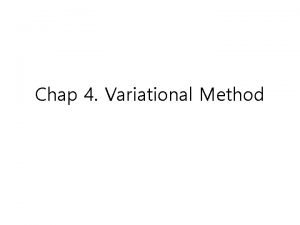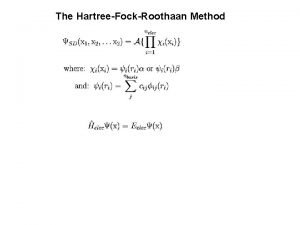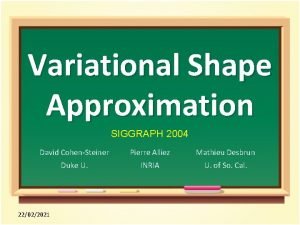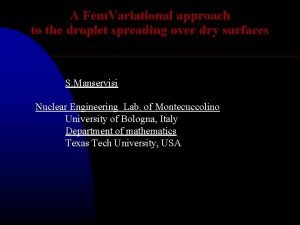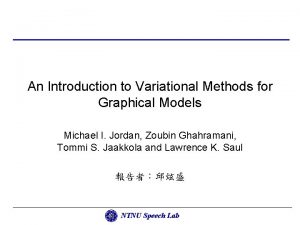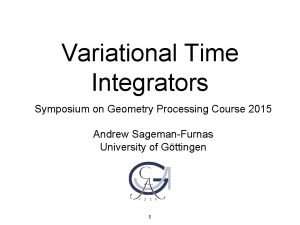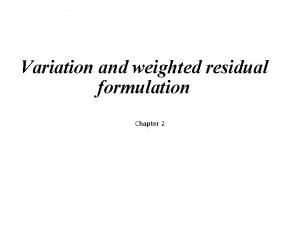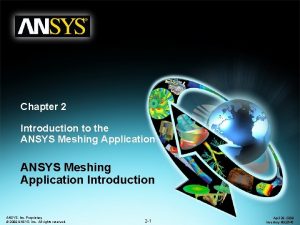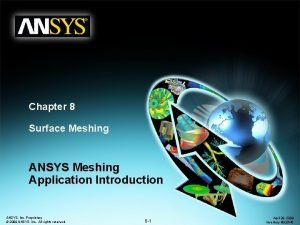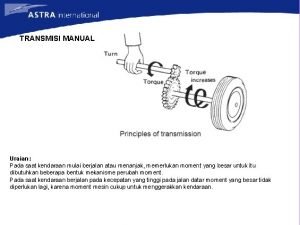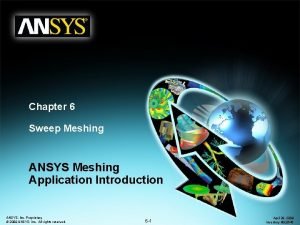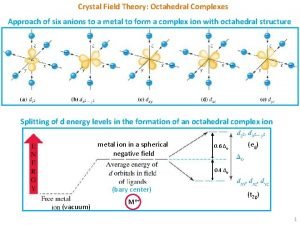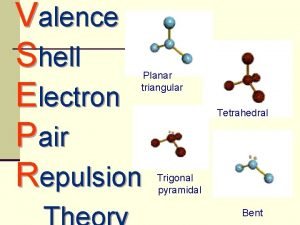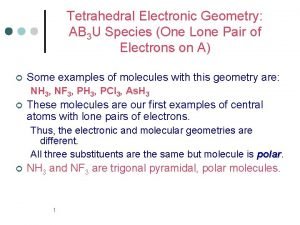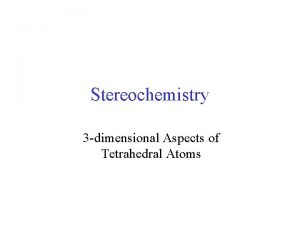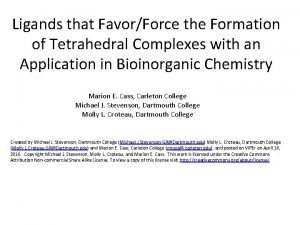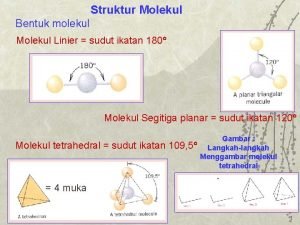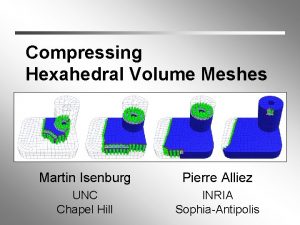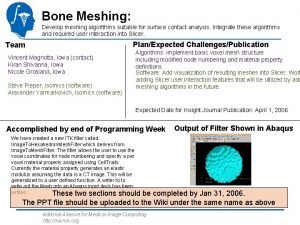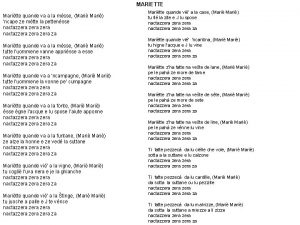Variational Tetrahedral Meshing Pierre Alliez David CohenSteiner Mariette




























- Slides: 28

Variational Tetrahedral Meshing Pierre Alliez David Cohen-Steiner Mariette Yvinec Mathieu Desbrun Figures and slides borrowed from: Bryan. K’s talk, Slides the authors posted, www. cs. uiuc. edu/class/fa 05/cs 598 anh/slides/Bell 2005_Al. Co. Yv. De 2005. pdf 1

Goals • 2 D: • • • In: Non-intersecting closed curve Out: Triangle Mesh 3 D: • • In: Given a watertight, nonintersecting manifold triangle mesh Out: Tetrahedral Mesh 2

Mesh quality • In this paper • radius-edge ratio = r in / rcirc 3

• Other requirements Graded mesh • • Tets size based on a sizing field Sizing field µ(x) : 3 • Indicate desired tet’s edge length near x 4

Algorithm Initialize vertices based on sizing field While (! Good enough quality) { Delaunay Triangulation/Tetrahedralization Optimize vertices position } 5

input domain 6

1 scatter points 7

1 scatter points 2 optimize topology 8

1 scatter points 2 optimize topology 3 optimize point position repeat 2 , 3 for 50, 000 tets, takes about 1 -10 seconds [Klingner et al. 06] 9

Optimization • Minimize area between PWL and paraboloid 10

Optimization • For fixed vertex locations • Delaunay triangulation is the optimal connectivity • • Exists for any points set Has several nice properties 11

Optimization • • • for fixed connectivity • min of quadratic energy leads to the optimal vertex locations xi is vertex i position |Ωi| is volume of tets in 1 -ring neighbor of vertex i 12

Optimal vertex position • • • For uniform sizing field, turns out to be |Ti| is volume of tet i ci is circumcenter of tet i 13

Optimal vertex position xi 14

Optimization: Init bad good distribution of radius ratios 15

Optimization: Step 1 bad good distribution of radius ratios 16

Optimization: Step 2 bad good distribution of radius ratios 17

Optimization: Step 50 bad good distribution of radius ratios 18

Graded mesh • So far, uniform, we also want: • To minimize number of elements • To better approximate the boundary • While preserving good shape of elements Sizing Field! 19

Sizing Field Properties: • size lfs (local feature scuize) on boundary • lfs = Distance to medial axis • sizing field is K-Lipschitz parameter 20

K=0. 1 K=100 21

22

Need to modify vertex optimization Intuition: Tet whose sizing field at circumcenter is small has big weight 23

Other details • Need to handle vertices near boundary specially • • The vertex optimization does not respect boundary Need to get rid of tets outside the mesh • Because DT include tets that cover convex hull 24

Boundary Handling • Create densely sampled set of points on the surface, quadrature points • Associate weight with each quadrature point • • • Corner - Infinite weight Crease - dl / µ(x)3 Surface - ds / µ(x)4 25

Boundary Handling • • Loop through all quadrature points, q • • Let v be the closest vertex to q S(v) = S(v) U {q} For all vertex v, • • If S(v) != Ø, • Position(v) = weighted average of position of q’s in S(v) Else • Position(v) will be determined by the optimization 26

Outside tet strippping • • The method in the paper does not seem to work. What we did: • Loop through all tets: • A tet is outside if 4 vertices of a tet are boundary vertices and • Its quality is bad OR • Its barycenter is outside • Then loop through all tets: • If >= 2 of its neighboring tets are outside (as determined from the previous step) , this tet is outside as well 27

Observations • Worst tets usually found near boundary • Worst tets quality improve when we replace circumcenter with barycenter in the vertex optimization • • No theoretical support Average quality decrease 28
 Mariette julien
Mariette julien Mariette meulman
Mariette meulman Variational methods
Variational methods The hamiltonian operator is given by
The hamiltonian operator is given by Variational shape approximation
Variational shape approximation Reboundd
Reboundd Variational knowledge graph reasoning
Variational knowledge graph reasoning An introduction to variational methods for graphical models
An introduction to variational methods for graphical models D'alembert
D'alembert Variational message passing
Variational message passing Weighted residual method
Weighted residual method Types of meshing in ansys
Types of meshing in ansys Ansys inflation
Ansys inflation Patch conforming method ansys
Patch conforming method ansys Momen yang besar dibutuhkan kendaraan pada saat
Momen yang besar dibutuhkan kendaraan pada saat Ansys sweep mesh
Ansys sweep mesh Mapped meshing
Mapped meshing Crystal field theory for tetrahedral complexes
Crystal field theory for tetrahedral complexes Trigonal planar
Trigonal planar Linear tetrahedral trigonal planar
Linear tetrahedral trigonal planar Oblique lattice
Oblique lattice Experimental math-music pavilion
Experimental math-music pavilion Edta complex
Edta complex Tetrahedral
Tetrahedral Specific rotation units
Specific rotation units Gaya van der waals adalah
Gaya van der waals adalah Tetrahedral complex
Tetrahedral complex Tetrahedral coordination complex
Tetrahedral coordination complex Sudut ikatan tetrahedral
Sudut ikatan tetrahedral


